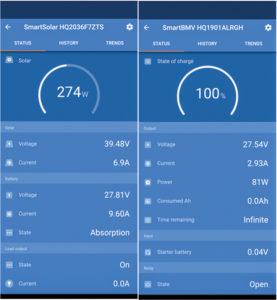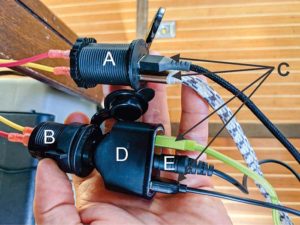This article was originally published in the September 2021 issue of 48° North.
About a year ago, my partner and I made the decision to leave our costly liveaboard moorage and make an attempt to stay at anchor for as long as possible. Since then, aside from a fuel-up or a week moored for repairs, we have lived and worked “on the hook” in various anchorages around the Salish Sea. Especially now that the weather has turned so fine, we have been getting more and more questions on how we keep the fenders up so long. Here are some tips to help you extend your time away from the dock in the Pacific Northwest.
Basics to Consider
Anchor Chain: Yes, this seems obvious, but consult the depth charts and have enough anchor chain to put out a minimum 5:1 ratio in the places you’re considering anchoring. Don’t skimp. Overkill is peace of mind when the gale warnings kick in.
Saltwater or “Raw Water” Pump: Avoid taxing potable water tanks to extend your time away. Clothes, dishes, people, or anything else can be washed in salt and then utilize a small amount of fresh water for a rinse.
Hotspot: Most cell phone plans these days will let you turn your smartphone into a powerful hotspot without any additional fees or devices. We’ve utilized this while working from home, and my partner can still conduct Zoom meetings to avoid eating up precious vacation hours. In remote locations, more sophisticated connectivity solutions are readily available, and have been discussed in various recent 48° North articles.
Jerry Cans: Having a few jerry cans on hand is not only handy for augmenting your existing diesel tank and extending the time between fuel dock visits, but they can be filled up on shore during a grocery run and hauled back in the dinghy.
Safety Devices: Consider a backup bilge pump or at least a high-water alarm and low voltage cut-offs suitable for your battery system to avoid draining them totally dead. Check your radio, lifejackets, emergency flotation devices, and first aid kits.
Food: Have an assorted stock of non-perishables that can either be meals on their own or could augment your fresh foods when you have them. We keep staples like canned fish, chickpeas, coconut milk, rice, etc., which can be made into standalone meals or added to curries, salads, and pasta dishes. And don’t forget the bounty of the sea itself. As we write this, we have a crab trap out and have been hauling in our catch limit of sweet Dungeness crab to be quick-steamed and covered in garlic butter (Figure 3). In the cooler months we take the dinghy into the shoreline in search of butter, horse, and geoduck clams. We’ve even pickled kelp and dried seaweed for miso soup.
Heat
If you’re accustomed to day-tripping or the occasional weekend away on the boat, you may have avoided investing in proper, systemic heating. We found out the hard way that unless it’s the peak of our short PNW summer, you’re not only going to suffer a real hit to quality of life that will drain the fun away very quickly, your boat will suffer too. Sure, you’ll be bundled up in wools, taking cold showers on deck, and drinking boiling hot coffee like a true turn-of-the-century hard-nosed sailor; but in the meantime, the lack of warm air and all the moisture from your breathing and cooking will be condensing on every cool surface. Condensation will mold your wood paneling, mildew your clothes, and rust your fixtures. Take it from us, even when the weather is fair, having a good heating source will help you stay on the hook for longer periods of time, and keep you happy while you do so. Go with one that can heat water as well as the air, so you may enjoy hot showers with world class views.
Creating Power
 You and your boat are used to having that steady, consistent shore power to not only keep the necessaries like your bilge pump functioning, but other amenities like charged electronics or a nice, cold fridge. Some pre-work is required to understand your power consumption needs and wants. Take a look around your boat and make a list of all the various background and foreground electric uses that draw power and estimate their daily wattage demands.
You and your boat are used to having that steady, consistent shore power to not only keep the necessaries like your bilge pump functioning, but other amenities like charged electronics or a nice, cold fridge. Some pre-work is required to understand your power consumption needs and wants. Take a look around your boat and make a list of all the various background and foreground electric uses that draw power and estimate their daily wattage demands.
Unhook from the shore power at the dock and see what the drawdown and hiccups are on a “normal” day without being skimpy. This also gives you a chance to find problems and adjust the power setup or replace connections. We discovered, for example, that our heater wouldn’t fire when the battery voltage got low, even though there was still plenty of electricity to run everything else. We invested in battery monitors with Bluetooth connections so we could monitor how fast our usage of certain electronics, like the TV or freezer, drained the batteries during days without shore power (Figure 1). This effort ahead of departure gives you an estimate of your needed watts (or amps x volts) per day and that can guide your decisions about electricity creating devices or saving measures.
When we started out, we had a diesel generator that needed to run for at least two hours twice per day to maintain our basic electric needs. Living at anchor comes with plenty of strains, but one of the benefits is supposed to be the quiet. Sounds like the wind singing in the rigging or the gentle lapping ocean against the hull were to be our reward, and instead we had four hours of motor noise chugging away affecting our work and relaxation.
Since then, we’ve switched to solar. The solar power industry has changed and improved rapidly (including since we last wrote about alternative energy sources for 48° North in 2016), so we simply tell everyone that they should have some kind of solar. Our 400W panel (purchased for $350 during a sale) has kept up with our demands, even with accommodating “luxuries”, visitors, or charging power tools — all the while providing peace of mind that we can create our own power without heading to shore.
The key is to get the right sized panel for your needs and to invest in a good solar charge controller (the device that distributes the incoming power from the panel to your batteries). We consulted with the expert marine solar installers, and they highlighted having an MPPT controller as a must. This smarter converter can increase the efficiency of your panel by 15-30% and we have been very pleased with ours as we track it on its Bluetooth app. This winter, we’ll be investigating wind generators to augment our solar setup.
Saving Power
Running around turning off lights in unused cabins may save you a handful of watts, but when it comes down to real energy savings, avoid using an inverter (if your boat has one). The best case scenario through an inverter is that your electronics draw from your batteries twice as much as they actually need, due to the back-and-forth-and-back conversion from DC to AC. Anything in your boat that can be run directly off your 12/24/48V battery bank should be converted to do so. Most of our electronics are now charged off of USB or a 12V plug that can utilize DC straight from the batteries (Figure 2).
Going Ashore
 This is actually one of the most important, and often overlooked, aspects of increasing your “hook time”. Check out a cruising guide or two that can offer some insight for marinas or anchorages, but also call ahead or visit the shore in person to figure out your options for tying up a dinghy, public transportation, and walkability to amenities. We have developed a conviction that a good shore experience really can help extend our stay.
This is actually one of the most important, and often overlooked, aspects of increasing your “hook time”. Check out a cruising guide or two that can offer some insight for marinas or anchorages, but also call ahead or visit the shore in person to figure out your options for tying up a dinghy, public transportation, and walkability to amenities. We have developed a conviction that a good shore experience really can help extend our stay.
One great example, despite the anchorage being tricky, is Friday Harbor. They have a guest dock and a dinghy dock, as well as a grocery store that offers dockside service, coin operated laundry in the marina, and nearby public transportation. We also have to mention Poulsbo, which has a nice solid anchorage in the winter and the drive for tourism, particularly boat tourism, has created great shore-going fun. Despite December cold, we’d often brave a dinghy ride to go in for a pastry and some strong coffee from the famous Sluy’s Bakery and stretch our legs wandering around the festively decorated town. When tie-ups are not available, look at anchorages that have a good shoreside landing and use inflatable dinghies or kayaks that are light or can be deflated and carried up the beach.
Enjoying Life at Anchor
Being at anchor is a bit like camping, you get the benefits of beautiful, quiet locations but have to factor in the logistics of keeping it going. Seeking out creature comforts will make this all the more rewarding, and the combination of smart planning and advancements in technology enable ever-longer stays at anchor. We are lucky to live in such a beautiful and abundant place, so pull up your fenders and try living on the hook for a while to enjoy it. We hope to see you out here.
Alex Wilken
Alex Wilken and his father, Jack, are lifelong cruisers, professional shipwrights, USCG licensed captains, and the owners of Seattle Boat Works.






